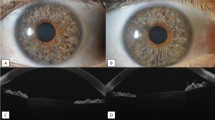Abstract
Four patients underwent photorefractive keratectomy for compound myopic astigmatism using the erodible mask. All achieved improvements in unaided visual acuities despite manifesting varying levels of decentration of the ablated zones. However, one patient had significant monocular diplopia because of the severity of the decentration. The problems with the present system include the use of a NON coaxial microscope; difficulty with obtaining and maintaining proper alignment of the excimer laser beam to the erodible mask and the central corneal zone; the inability to interrupt and restart the procedure due to the ablation of the reference marks on the mask; and patient discomfort. We suggest installation of the PMMA mask at the laser aperture in order to alleviate the above difficulties. In the meantime, use of a coaxial microscope, a limbal suction device for fixation, permanent reference marks on the mask and peribulbar anaesthesia may be helpful.
Similar content being viewed by others
References
Zabel RW, Sher NA, Ostrov CS, Parker P, Lindstrom RL. Myopic excimer laser keratectomy: a preliminary report. Refract Corneal Surg 1990; 6: 329–34.
McDonald MB, Frantz JM, Klyce SD, et al. Central photore-fractive keratectomy for myopia. The blind eye study. Arch Ophthalmol 1990; 108: 799–808.
McDonald MB, Liu JC, Byrd TJ. Central photorefractive keratectomy for myopia. Ophthalmology 1991; 98:1327–37.
Gartry D, Kerr Muir MG, Marshall J. Photorefractive Keratectomy with an Argon Fluoride Excimer Laser: A Clinical Study. Refract Corneal Surg 1991; 7: 420–35.
Sher NA, Chen V, Bowers RA, et al. The use of the 193-nm excimer laser for myopic photorefractive keratectomy in sighted eyes. A multicenter study. Arch Ophthalmol 1991; 109: 1525–30.
McDonald MB, Liu JC, Byrd TJ, et al. Central photorefractive keratectomy for myopia. Partially sighted and normally sighted eyes. Ophthalmology 1991; 98:1327–37.
McDonnell PJ, Moreira H, Clapham TN, D'Arcy J, Munnerlyn CR. Photorefractive keratectomy for astigmatism. Initial clinical results. Arch Ophthalmol 1991; 109:1370–3.
Gordon M, Brint SF, Durrie DS, et al. Photorefractive keratectomy at 193 nm using an erodible mask. SPIE Proceedings, 1664, 1992.
Seiler T, Bende T, Wollensak J, Trokel S. Excimer laser keratectomy for correction of astigmatism. Am J Ophthalmol 1988; 105:117–24.
Author information
Authors and Affiliations
Rights and permissions
About this article
Cite this article
Balakrishnan, V., Lim, A.S., Tseng, P.S. et al. Decentered ablation zones resulting from photorefractive keratectomy with an erodible mask. Int Ophthalmol 17, 179–184 (1993). https://doi.org/10.1007/BF01007737
Received:
Accepted:
Issue Date:
DOI: https://doi.org/10.1007/BF01007737




